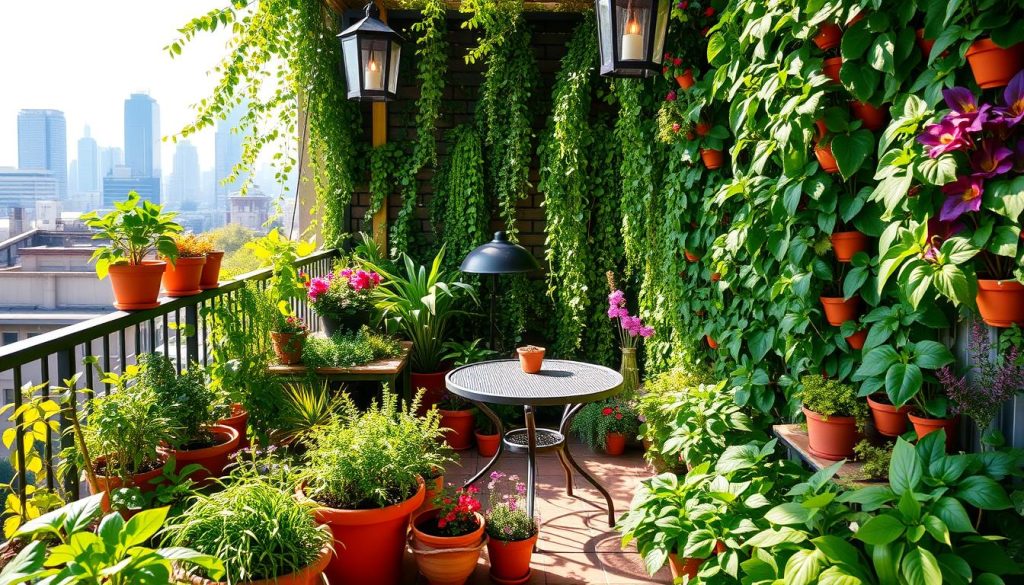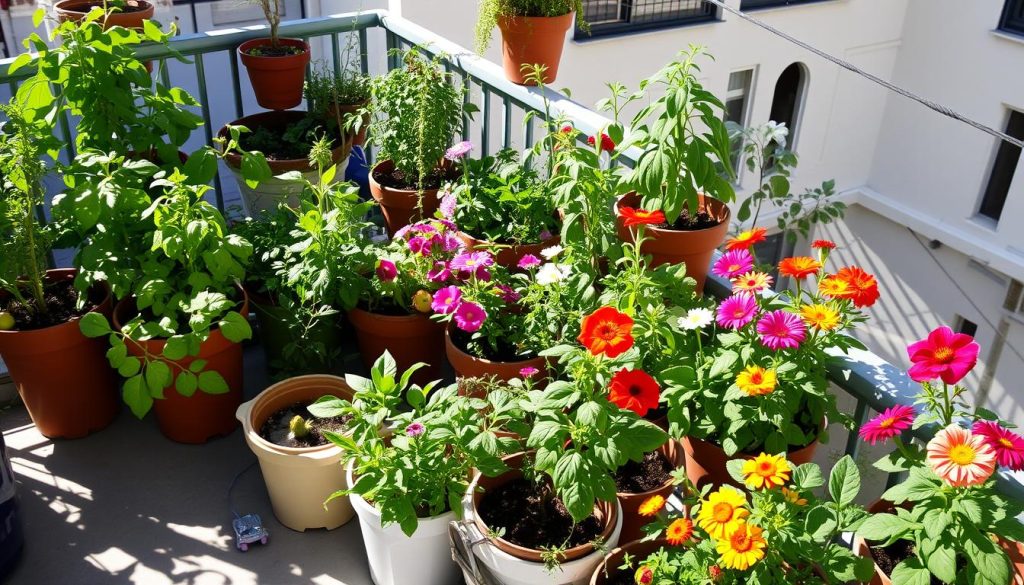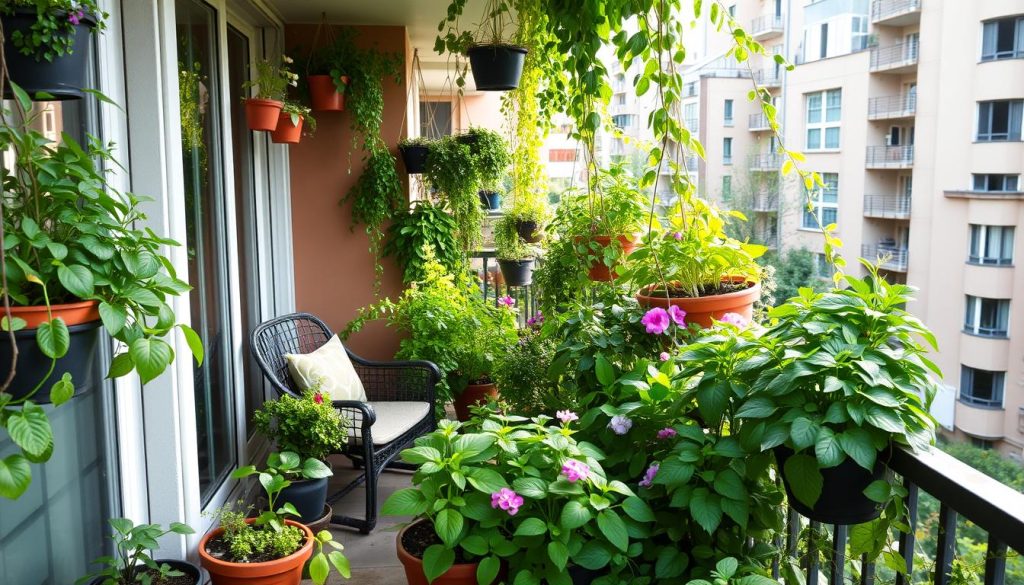More people living in cities are starting balcony gardens. These small spaces let you grow plants without a big backyard. To succeed, plan well, choose the right plants, and use space wisely.
Balcony gardens are easier to care for than big gardens. They have fewer weeds and are safer from pests and bad weather. They also bring a piece of nature to city life. Start small and add plants little by little to make your balcony a beautiful spot.

Key Takeaways
- Balcony gardens offer apartment dwellers the opportunity to grow plants without a backyard
- Careful planning and selecting manageable plants are essential for small balcony spaces
- Proper drainage and container selection are crucial for balcony plant health
- Vertical gardening can maximize growing area without taking up floor space
- Balcony gardens can provide a soothing connection to nature in urban environments
Understanding the Benefits of Balcony Gardening
Balcony gardening is becoming more popular, especially for those with small spaces. It’s a great way to enjoy container plants and urban gardening. These activities offer many benefits, not just for personal enjoyment.
Mental Health Advantages
Balcony gardens create a calm and peaceful spot. They help with mindfulness and meditation. Caring for plants gives a sense of purpose and routine, improving mental health.
Studies show that green spaces can make us feel better emotionally. They can boost our mood and overall well-being.
Physical Health Benefits
Growing your own garden can make you eat healthier. You’ll have fresh herbs, veggies, and fruits for cooking. This can lead to a more balanced diet.
Gardening also gets you moving. It’s a form of exercise that can improve your fitness. Plus, it helps you get Vitamin D from being outside.
Environmental Impact
Balcony gardens are good for the environment. They add greenery to urban areas, improving air quality and producing oxygen. They also help with environmental sustainability.
These gardens support biodiversity by providing homes for pollinators and beneficial insects. They make our communities greener and healthier.
Balcony gardening has many benefits, from mental health to environmental impact. As more people garden in small spaces, they discover the joys of their own urban oasis.
Getting Started: Essential Planning for Small Spaces
Balcony gardening needs careful planning to use space well. Start by measuring your balcony and thinking about what you want to grow. Whether it’s a lush green space or a garden full of food, a good plan is essential.
Think about the rules and weight limits that might affect your plants and containers. Also, check how your balcony’s weather affects it. Sun, wind, and temperature all play a part in what plants will do well.
- Measure your balcony’s dimensions and create a layout plan.
- Determine your gardening goals, such as growing flowers, herbs, or vegetables.
- Investigate weight restrictions and building guidelines that may affect your garden design.
- Assess your balcony’s microclimate, including sun exposure, wind patterns, and temperature.
With careful planning, your balcony can become a lush, efficient garden that meets your needs. Even the smallest balconies can be turned into green havens with the right approach.
Smart Container Selection for Limited Spaces
Gardening on a balcony or patio means choosing the right containers is key. The right containers can turn a small garden into a thriving oasis. Whether you’re growing plants in containers, creating a patio garden, or enjoying urban gardening, picking the right containers is crucial.
Drainage Requirements
Drainage is vital for container plants. Make sure your containers have enough holes to let water out. This prevents waterlogging and root rot, keeping your plants healthy in small spaces.
Material Considerations
The material of your containers matters too. Choose lightweight materials like fabric or plastic. They’re easy to move and won’t harm your balcony. Plus, they’re weather-resistant, standing up to the elements.
Size and Shape Options
- Think about how big your plants will get and pick containers that fit.
- Use space-saving shapes like rectangular planters to save room.
- Try vertical gardening with hanging baskets or wall-mounted planters to use your balcony’s height.
By picking the right containers, you can create a beautiful urban garden. Whether you’re growing plants, creating a patio garden, or enjoying urban gardening, the right containers are essential.
Maximizing Vertical Space in Your Garden
To create a thriving vertical gardening oasis in your small small space gardening areas, like a balcony garden, use every inch of vertical space. This method lets you grow more without taking up too much floor space. It’s perfect for making the most of your small urban area.
Use walls, railings, and overhead spots to hang plants, install shelves, or set up trellises. These solutions not only save space but also make your balcony garden look great. Think about using old ladders or pallets to create unique vertical gardens.
- Vertical gardening is great for small or limited spaces, perfect for city folks or those with tiny outdoor areas.
- By growing plants up instead of out, vertical gardens can hold more plants in less space. This means you can grow more and harvest more.
- Vertical gardening also helps prevent soil erosion and water runoff. It keeps soil in planters or containers, leading to healthier plants and less erosion risk.
This gardening method is perfect for urban areas where space is tight. It works well in both indoor and outdoor spaces. Options like trellises, arbors, and wall-mounted planters can turn your balcony garden into a vertical paradise. It shows off the beauty of small space gardening at its best.
Understanding Your Balcony’s Microclimate
Urban gardening and balcony gardening need you to know your balcony’s microclimate. This is key for your plants to grow well. Look at the sun, wind, and temperature changes to make a great place for plants.
Sun Exposure Assessment
Start by checking how much sun your balcony gets. Different plants need different amounts of light. Find out where it’s sunny, partly shaded, or very light.
Choose plants wisely for each spot. For example, tomatoes and peppers need lots of sun. Put them near the balcony’s edge. Herbs and leafy greens do well in the shadier spots.
Wind Factors
Wind can hurt your plants. It can damage leaves and stop plants from growing. Use things like privacy screens or trellises to block the wind.
Put tough plants in windy spots. This helps your garden do well.
Temperature Considerations
Temperature changes can affect your plants. Heat from windows or the balcony can make some spots warmer. Choose plants that can handle heat.
Also, add shade where needed. This helps your plants grow well in different temperatures.
Knowing your balcony’s microclimate helps you create a great garden. You can make your urban or balcony garden perfect for your plants.
Space-Saving Plant Selection Strategies
When gardening in small spaces like balconies, it’s key to pick plants that save space. Look for dwarf or “patio” varieties of your favorite plants. They give great results but take up less room. Herbs are also great because they look good and you can eat them, making your garden useful.
To make the most of your space, mix different types of plants. Use upright, trailing, and spreading plants to make your garden look good and use all the space. This way, you get the most out of every inch of your balcony garden.
Most importantly, choose plants that do well in your balcony’s conditions. Think about sun, wind, and temperature to pick the right container plants for your small space gardening or urban gardening setup. With the right plants, you can have a lush, productive balcony garden, even in a small space.
By choosing the right plants, you can turn your balcony into a beautiful oasis. With the right mix of compact, multi-purpose, and site-appropriate plants, you’ll succeed in small-space gardening.
Efficient Watering Solutions for Balcony Gardens
Keeping a balcony garden alive needs smart watering strategies. Whether you have many container plants or enjoy urban gardening, the right watering can keep your space green and vibrant.
Irrigation Methods
Self-watering planters are a hit among balcony gardeners. They have built-in water tanks that save you from daily watering. Collapsible watering cans and expandable hoses also help, fitting well in small spaces.
Water Conservation Tips
- Place saucers under pots to catch extra water and avoid waste.
- Choose plants that don’t need much water, especially in hot or windy weather.
- Try DIY watering systems like a bottle with holes to water plants efficiently.
- Think about getting a smart watering system that waters plants just right, based on soil moisture.
Using these smart watering tips, you can have a beautiful balcony garden that saves water. Enjoy the easy, green space you’ve created.
Creative Storage and Organization Ideas
Maximizing space is crucial in small space gardening. Creative storage solutions help a lot. Whether you have a cozy balcony or a small patio garden, there are many ways to stay organized and clutter-free.
Using multi-functional furniture with built-in storage is a great idea. For instance, a storage bench can serve as a place to sit and hide gardening tools and cushions. Vertical cabinets and shelves are also excellent for small spaces. They let you store potting supplies, decorations, and even small garden tools.
- Use wall-mounted pegboards or hooks to hang gardening tools, keeping them within easy reach.
- Repurpose items like shoe organizers or trays to neatly store small gardening supplies, seeds, and other accessories.
- Explore under-bench or railing storage solutions for larger items like potting soil, plant pots, and outdoor furniture cushions.
By using these smart storage ideas, you can turn your small space gardening or balcony gardening area into a neat and useful patio garden oasis. Stay organized and make the most of your limited square footage with these creative storage solutions.
Year-Round Maintenance Tips
To keep your balcony garden alive, you need to change your care with the seasons. Knowing how to care for your plants in each season helps them grow well, even in small spaces.
Seasonal Care Guidelines
When the seasons shift, so does your gardening routine. In spring, clean your containers, add new soil, and start planting. Summer means watering more often and watching for pests. Fall is great for planting bulbs and getting ready for winter. Winter requires protecting plants from frost and watering less.
Pruning and Trimming Techniques
Pruning and trimming are key for a healthy, beautiful balcony garden. Remove dead flowers to get more blooms and cut back overgrown plants. This keeps your garden looking good and helps prevent disease.

Adjusting your care to the seasons and regular pruning keeps your plants thriving all year. This turns your balcony into a lively, green oasis.
Growing Edibles in Small Spaces
Balcony gardening lets you grow your own herbs and veggies, even in tiny spaces. By picking compact plants and using vertical space, you can enjoy fresh produce from your balcony.
Herbs are great for small gardens. Basil, mint, parsley, and more can grow in containers. You can also grow dwarf tomatoes, peppers, and leafy greens like lettuce and spinach. Choose varieties that won’t grow too big for their space.
Vertical gardening makes the most of your balcony. Use trellises, hanging planters, and stackable planters for climbing veggies and trailing plants. This way, you save floor space.
Keep an eye on your herb garden and vegetable garden on your balcony. Containers in windy spots need more water. Shady areas are perfect for salad greens. With the right care, your balcony will give you a lot of fresh produce.
Design Principles for Visual Impact
To make your balcony garden stand out, you need to think about design. It’s about choosing colors and arranging things right. This way, even a small space can feel welcoming and beautiful.
Color Coordination
Choosing the right colors is crucial for a unified look. Match your balcony garden’s colors with your home’s decor and furniture. Mixing bold and soft colors makes your space more interesting.
Layout Planning
Planning your balcony garden’s layout is important. Use focal points like big planters or trellises to catch the eye. Mix different heights and textures to make it visually appealing from inside and outside.
By following these design tips, you can turn your balcony gardening, small space gardening, or patio garden into a stunning oasis. It will show off your style and make your outdoor area look great.
Weight Management and Safety Considerations
Balcony gardening needs careful thought about weight and safety. It’s key to know your balcony’s weight limit before starting. Choose light containers and potting mixes to keep the weight down.
It’s also important to secure your containers and furniture to stop them from tipping in the wind. Make sure your containers drain well to avoid water damage. By focusing on weight and safety, you can make a beautiful balcony garden that’s safe and stable.
Lightweight Materials for Containers
- Opt for light containers like plastic, polystyrene, or lightweight ceramic pots.
- Use a well-draining, soilless potting mix to cut down on container weight.
- Add perlite or other light additives to your potting mix.
Securing Your Balcony Garden
- Anchor your containers and furniture to prevent tipping in windy conditions.
- Ensure proper drainage to avoid water accumulation and potential structural damage.
- Check your balcony’s weight-bearing capacity and adhere to any building regulations.

Remember these tips for weight and safety to make a lovely balcony garden. It will make your urban living better.
Best Plants for Small Space Success
Choosing the right plants is crucial for a successful small space garden. Think about your balcony’s microclimate and growing conditions. Succulents and cacti are great for hot, dry spots. Ferns and hostas are perfect for shaded areas.
Dwarf fruit trees like citrus or olive are great for adding edible greenery. Annual flowers bring color for the seasons. Perennials add structure and interest year-round. Make sure to check each plant’s needs and hardiness zones for a vibrant garden.
- Succulents and cacti for hot, dry balconies
- Shade-loving plants like ferns and hostas for covered areas
- Dwarf fruit trees, such as citrus or olive, in larger containers
- Annual flowers for seasonal color
- Perennials for long-term structure and interest
By picking plants that fit your balcony’s environment, you can create a beautiful garden. Your balcony can become a lush oasis, even in the city.
Multi-Functional Garden Elements
In urban and small space gardening, making the most of each element is crucial. This way, you can turn your balcony or small outdoor space into a lush oasis. It becomes a place that meets your needs and makes your life better.
Climbing plants on trellises are very versatile. They add beauty and privacy, and even provide shade. Choose fast-growing, fragrant vines like Jasmine or Honeysuckle for a sensory delight.
Living walls are another great space-saving idea. They are beautiful and help clean the air by removing pollutants and adding oxygen. Pick easy-to-care-for plants like Pothos, Snake Plant, or Peace Lily for a vibrant wall.
- Invest in furniture with built-in planters to maximize your limited space. This allows you to incorporate additional greenery while providing functional seating or storage areas.
- Create a cozy, multi-sensory seating nook surrounded by fragrant herbs or flowers. The sights, scents, and textures will transport you to a serene, relaxing oasis in the heart of the city.
By using these multi-functional garden elements, you can turn your small garden into a beautiful, functional space. Small space gardening opens up endless possibilities for your outdoor area.
Conclusion
Balcony gardening is a great way to connect with nature in cities. It requires careful planning and the right plants to make a small balcony bloom. It’s perfect for both experienced gardeners and beginners, turning any balcony into a peaceful retreat.
This hobby has a rich history, dating back centuries. It became more popular in the 19th and 20th centuries as cities grew. Now, with vertical gardening and new products like the Sprout Planter, balcony gardening keeps evolving.
As people seek greener living, balcony gardens are becoming more common. They offer a break from city life, reducing stress and boosting mood. By gardening on your balcony, you can create a space that’s both personal and eco-friendly, making your city a greener place.